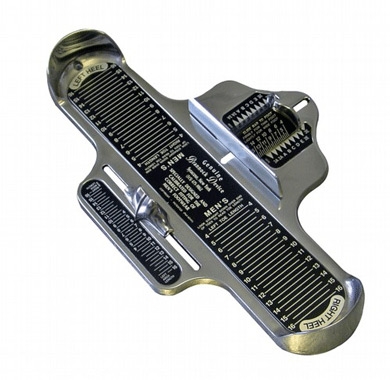I have a three-year-old daughter whose schedule is surpassed only by my wife’s in density. On a recent and particularly packed Saturday we found ourselves with 50 extra minutes in between the end of a birthday party and a scheduled flu shot. We decided to hit the mall to pick up a new pair of shoes for my daughter. We stopped in at a general shoe store (read Do-It-Yourself) and measured her feet, only to find that they did not have the style we wanted in her size.
Now we are down to 30 minutes, but there is another shoe store down the hall so we proceed post haste. They do not have anything that works for us either, but they did have good service so it didn’t take long to come to this conclusion. But we’re now down to 25 minutes.
On the way to the next shoe store I drop into Dillard’s as the shoe department is visible from the mall. The sales person asks if we know what we need and we tell her which shoe and that we need a size 9. She asks, “Have you had her measured?”. I said, “Yes, we did it just moments ago.” The salesperson rolls her eyes and wordlessly turns to retrieve her Brannock Device. I tell her again that my daughter’s foot measures a size 9 and she just looks at me. We both stand and stare at each other for what seemed like an eternity. “Fine” I said, “measure her,” and then tell my wife (a bit too loudly) declares that, “This type of attitude makes me not want to shop here.”
It’s about this time that I look down to see that my daughter’s big toe is sitting squarely on 9 1/2. “And,” the salesperson says, “the shoes you want run small so you should buy her a size 10.” I said, “OK” and she disappears into the back room. We replace the shoes on the display rack, the salesperson returns and says, “What, you don’t want them?” I assured her that we do and thought she had gone to retrieve them. She says, “No, the display are the only 10s I have.”
After leaving the mall my wife says, “She sure got under your skin didn’t she?” I unleash a tirade about making my living as a professional measurer, about the complex objects I am required to dimension for people and corporate entities that are a lot more demanding than your average department store shopper. “Well, it’s a good thing that she didn’t listen to us or we would have bought the wrong size!” my wife reminded me.
My wife was right. We needed the service, we would have been worse off without it, and it was performed accurately. So, why did I leave unsatisfied? I started to look at what I had brought to the exchange. I was tired and was only halfway through what I needed to do that day. I was in a very big hurry due to other commitments, and I had already invested time in solving the size issue. Sound like any of your clients?
This experience forced me to evaluate my performance in ways that have nothing to do with how well I measure. As service providers we often focus on performing our service accurately. Perhaps the focus should be on performing it properly. While what you deliver is important, how you deliver it has a lot to do with the feelings your client has about your performance. I can’t change how my clients come to me, but I can control how I receive them.
- First and foremost, lose the attitude. Making some non-verbal gesture or having a general demeanor that indicates that you think your client is clueless is just stupid. Even if they are clueless, how does expressing this to them help you?
- Maintain good communications. The longer she went without communicating to me the reason(s) for her actions the more I felt like my time was being wasted.
- Find alternate ways to accomplish your tasks. If the pair we wanted ran small as she said, she could have brought out a size 9 and a size 10. One fits, one does not, entire measurement issue avoided.
- Realize that you never have all of the information. She had no idea about what I do for a living. I think there are less than 10 of us in the Nashville area that have any experience running a scanner so the odds of it happening again are rather small. However, her assumption seemed demeaning to me and I don’t think that demeaning your customer is a good way to build a business. On this issue I’m with former President Reagan – “Trust, but Verify.” If you can’t verify that your client understands the issue at hand, educate them. But do so in a way that is empowering instead of demeaning.
- Being correct does not mean that you are right. In the end, for whatever reason, the shoe salesperson was right. Maybe the first store had an un-calibrated Brannock Device. Maybe my daughter’s foot grew while in the second store. Maybe I need more practice measuring feet! Whatever the reason, I received the services that I needed but I did not leave with the feeling of being well served.
I hope we can all keep these things in mind the next time we interact with a client. Being accurate and correct are paramount but a client base is built upon personal relationships; and those take more than just being accurate.






